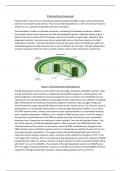Essay
Unit 10 Aim C: Photosynthesis Assignment (DISTINCTION)
- Course
- Institution
This is my distinction grade assignment for unit 10 aim C on photosynthesis and factors which affect it. All criteria were met and I was awarded distinction. If you have any questions or concerns, please do not hesitate to get in touch. I hope you find my assignment helpful!
[Show more]




